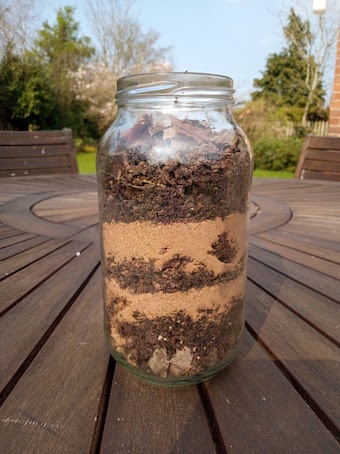
As all gardeners know, good soil is one of the main secrets of growing good plants. Without soil, there would be very few plants on land at all. So, what is soil made of and where does it come from? A good way to start exploring this is to dig a hole in the garden. Depending on the location, there may be some organic material (dead leaves etc) on the surface, then some good dark soil, but further down you will encounter paler soil, most probably with a mixture of stones in clay or sand, and if you dig far enough you may hit solid rock. Soil is a mixture of mineral particles weathered from rocks and organic material from decaying plant material.
To see what your own soil is made of, take a large jar with a wide mouth and a screw-on lid (this will also be useful for the wormery project below) fill it about 1/3 of the way with soil, including material from the surface down to depth of 6-12 inches, then top it most of the way up with warm water, screw the lid on and give it a good shake. Leave it a few hours to settle and you should find that you have several different layers. At the bottom will be any stones or gravel in the soil. Above this there may be a sand layer, then one or more soil layers. Any fine clay will remain suspended for a long time in the water, though fine clay particles should gradually settle out on top of the soil. Finally, some organic material may remain floating on the surface. The relative thickness of these layers will give an idea of the composition of your soil.
Worms make an important contribution to the health of the soil. They feed by eating soil and extracting bits of dead plant or animal material from it. In the process they mix up the soil with their burrowing and enrich it with humus by pulling leaves down into the soil. You can see this at work by setting up a wormery, as shown in the picture on the right, which is taken from this Woodland Trust guide.
 What
you need is a transparent (glass or plastic) container with
vertical sides and a wide mouth. A large drinks bottle with
the top cut off will work if you don't have a suitable vase or
jar. Put some stones, gravel or sand in the bottom to provide
drainage, then fill the container with soil, incorporating a
few layers of sand. Place a few dead leaves on the
surface and then add a few worms and watch what happens over
the course of a few days. Your wormery needs to be kept in a
cool dark place. Worms will avoid the light, so if you
don't have a dark place then you should wrap dark paper round
the jar, which you can remove to inspect their tunnels. Return
your worms to the garden when you have finished watching them.
What
you need is a transparent (glass or plastic) container with
vertical sides and a wide mouth. A large drinks bottle with
the top cut off will work if you don't have a suitable vase or
jar. Put some stones, gravel or sand in the bottom to provide
drainage, then fill the container with soil, incorporating a
few layers of sand. Place a few dead leaves on the
surface and then add a few worms and watch what happens over
the course of a few days. Your wormery needs to be kept in a
cool dark place. Worms will avoid the light, so if you
don't have a dark place then you should wrap dark paper round
the jar, which you can remove to inspect their tunnels. Return
your worms to the garden when you have finished watching them.
Many other creatures can be found in the surface layers of soil. The richest collection can usually be found under trees, where there is plenty of leaf litter. One way of discovering what creatures live in this surface layer is to make a trap. Sink a jar in the ground with its mouth level with the ground, place a few leaves and twigs around the rim and then wait a few hours to see what falls into your trap. A magnifying glass will help you to study anything you catch, before returning it to the leaf litter. A simple identification guide to some of the most common "minibeasts", from the RSPB, can be found here. Another method for studying creatures in the surface layers of soil is to collect a few scoops in a carrier bag and tip it little by little into a sieve on top of a white container. Creatures which fall through can be studied. You may find a small paintbrush useful for moving them gently around. You can encourage more creatures to fall through the sieve by shining a lamp onto the top of the material in it - creatures will move away from the light. You can keep your minibeasts for a few days if you provide them with a suitable home. What you need is a container with a lid in which you can punch a few holes. This should contain some damp soil with leaf litter and perhaps a little decaying wood and a stone, and should be kept out of bright light. You can then investigate which creatures move around, which will hide under a stone, which burrow into the soil, which seem to be interested in the decaying wood etc.